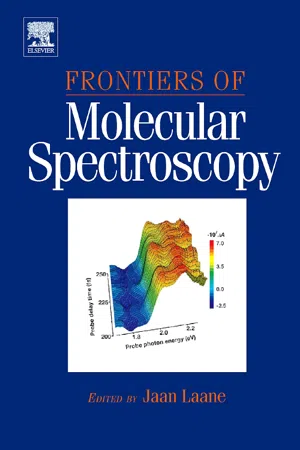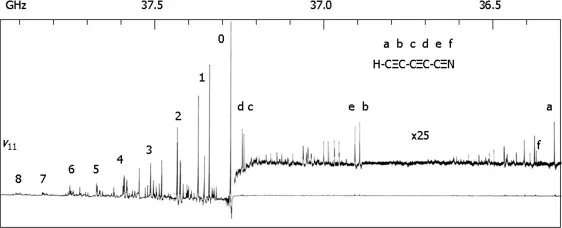![]()
Chapter 1. Acknowledgements
I thank all the numerous friends and colleagues, many of them mentioned by name in this review, with whom I have worked or who have clarified many problems for me.
In this chapter, a personal perspective is presented on the fascinatingly wide impact of molecular spectroscopy – in particular microwave (rotational) spectroscopy – on an amazingly wide range of key areas in the sciences. In addition to its fundamental role in revealing a wealth of detailed intrinsic information about molecular structure from bond lengths to bond angles, it has also revealed intimate details of molecular dynamics, including internal rotation parameters and the effects of quantum mechanical tunnelling. No less important has been its more general contributions, where it has led to the development of new areas of mainline chemistry as well as the birth of the field of interstellar chemistry and our understanding of how stars start to form. The impetus for the experiments that uncovered the existence of the fullerenes can be traced back to microwave spectroscopy studies, which had initiated radio astronomy detection of carbonaceous molecules in space. It is also interesting to note that the inventor of the maser/laser and one of the proponents of the leading theory of superconductivity were pioneers in molecular microwave spectroscopy.
1. Introduction
Spectroscopy is arguably (and I would argue it) the most fundamental of the experimental physical sciences. After all we obtain most of our knowledge through our eyes and it is via the quest for an in-depth understanding of what light is, and what it can tell us, that all our true understanding of the universe has been obtained. Answers to questions about light have led to many of our greatest discoveries, not least our present description of the way almost everything works both on a macroscopic and a microscopic scale. In the deceptively simple question of why objects possess colour at all – such an everyday experience that few think it odd – lies the seed for the development of arguably our most profound and far-reaching theory – quantum mechanics. The realisation that colour is not explainable classically was one catalyst of quantum mechanics and quantum electrodynamics. The Theory of Relativity also was born out of observations on the subtle behaviour of light with very deep consequences. Few scientific quests have been of more fundamental significance than those involving the corpuscular and wave nature of electromagnetic radiation that Newton and Huygens discussed which, together with the work on electricity and magnetism of Ampère and Faraday, led to the unification that Maxwell uncovered when he showed that electromagnetic interactions travelled at the velocity of light. A beautiful set of four lectures by Richard Feynman on this subject was recorded at the University of Auckland in New Zealand (1979) and can be viewed streaming from the Vega Science Trust website (www.vega.org.uk) [1]. The breakthrough that, more than any other, signified the birth of not only astrophysics but also spectroscopy in general lies in the work on the dark sharp absorption lines in the solar spectrum that Joseph von Fraunhofer realised could be identified with atoms of elements known on Earth, such as sodium. It often amuses me to think that the NaD doublet was labelled “D” only because – presumably – it was the fourth feature to be labelled by Fraunhofer. Amazingly, spectroscopy allows us to carry out chemical analysis on objects not just millions of miles away but billions of light years away.
The original quantum mechanical work of Heisenberg indicates that he and others such as Max Born were attempting, among other things, to understand the quantum harmonic oscillator – the fundamental mechanical system in engineering as well as classical and quantum physics [2]. Once these and other fundamental quantum issues had been resolved, almost the whole of the modern description of world followed – at least in the more-or-less non-relativistic regime. Few concepts capture the imaginations of non-scientists, no less than scientists, than the Big Bang Theory of the origin of our universe which finds its major support in spectroscopic observations such at the (Red) frequency shifts observed for atomic lines in stellar spectra and of course the blackbody contour of the microwave background.
2. Microwave Spectroscopy: A Fundamental Analysis
This chapter concentrates primarily on various aspects of spectroscopy – mainly microwave – and astrophysical spectroscopy from a personal perspective of the way it has impacted on other areas of the science in ways that I find interesting. This perspective developed over a long period, at one stage encapsulated in a monograph in 1974 [3] and then in 1981 in a review [4]. The astrophysical perspective was also encapsulated in a review some time ago [5] but more recently in a set of seminars streaming from the website www.vega.org.uk [6]. This chapter is not by any means meant to be a complete survey and I apologise if many very important advances have been omitted – partly because my perspective is limited and partly because I am not as close to the field as I once was. It is somewhat ironic for me that the one field that I vaguely understood required that the molecules to be studied possess dipole moments and I was dragged away from the field screaming by a spheroidal molecule that has almost no useful moments at all – let alone a dipole moment. I had first become fascinated by molecular spectroscopy while studying the visible spectrum of a Bunsen burner flame through a spectroscope. I still have my practical book containing my Birge–Sponer plot for the C2 radical. I became completely enamoured in general during an undergraduate lecture course on molecular spectroscopy by Richard Dixon at Sheffield University. I was introduced to elegant rotational branch structures which indicated that molecules could count. From there I was led on to carry out research on the spectra of small free radicals produced, detected and studied by flash photolysis and electronic spectroscopy, the technique pioneered by George Porter, who was then the Professor of Physical Chemistry at Sheffield University. Dixon had built a large Eagle grating spectrometer to detect the spectra at what was then “very” high resolution just as the first rumblings of the possibilities of using something called an “optical maser” to carry out spectroscopy could be heard. In 1964 I went on to the National Research Council (NRC) in Ottawa, where Gerhard Herzberg and Alec Douglas had created the legendary “Mecca” of spectroscopy. At first I worked with Don Ramsay and then I discovered microwave spectroscopy and transferred to Cec Costain’s group; from that moment on the future direction of my career as a researcher was sealed. I gained a high degree of satisfaction from measurements made at high resolution on the rotational spectra of molecules and in particular from the ability to fit the frequency patterns with theory to the high degree of accuracy that this form of spectroscopy offered. At that time tunable lasers were not available and UV and IR techniques just did not compare in attainable resolution. Great intellectual satisfaction comes from knowing that the parameters deduced – such as bond lengths, dipole moments, quadrupole and centrifugal distortion parameters – are well-determined quantities both numerically and also in a physically descriptive sense. Some sort of odd schizoid understanding seems to develop as one gains more and more facility (rather than familiarity?) with the abstract quantum mechanical (mathematical) approaches to spectroscopic analyses. The quantitative perspective adds to the (subliminal?) classical physical descriptions needed to convince oneself that one really does know what is going on. One thing “fundamentalist” spectroscopists (microwavers?) can say is, “We may not know much, but what we know we really do know – a lot about very little – things”. I was to learn later that such levels of satisfying certainty of knowledge are a rarity in many other branches of science and in almost all areas of life in general. It gives one a very clear view of how the scientific mindset develops and what makes science different from all other professions and within the sciences a clear vision of what it means to really “know” something.
The equations of Kraitchman [7] and the further development of their application by Costain [8] to isotopic substitution data in the 1960s resulted in a wealth of structural information on small- to moderate-sized molecules from microwave measurements on rotational structure. At Sussex in 1974, my colleague David Walton and I put together a project for an undergraduate researcher, Andrew Alexander, to synthesise some long(ish) linear carbon chain species starting with HC5N and study their spectra – IR and NMR as well as microwave [9]. Of key interest for me was a study of the low-frequency bending vibration. One of Alex’s rotational bands is shown in Figure 1 [3,9], where a particularly neat phenomenon can be semi-quantitatively observed. Kraitchman and Costain [6,7] showed that for a linear molecule, with moment of inertia I, on substitution (new moment of inertia I*) the distance of a substituted atom r* from the centre of mass of the unsubstituted molecule is governed by the relation I* − I = μr*2, where μ = ΔmM/(Δm + M), with M being the total mass and Δm the increase in mass on substitution. As the rotational constant B ∝ I−1 and BB* is almost constant especially for 13C and 15N substitutions, where the increase is only 1 AU, the change in B value on substitution follows the relation ΔB ∝ r*2 quite closely. The centre of mass ofH−CaCb−CcCd−CeNlies near the midpoint of the CcCd triple bond and so substitution of 13C at Cc and Cd gives rise to the smallest shift; substitutions at Cb and Ce yield shifts roughly 32×larger, and 13C and 15N substitutions at the Ca and the N atom positions respectively give shifts roughly 52×larger. The spectra of the 13C- and 15N-substituted species can be observed at natural abundance in Figure 1. In such simply appreciated effects lie some of the greatest delights in science [3,4,9].
Figure 1. The microwave spectrum of HC5N. To the RHS of the ground vibrational state line can be seen the weak spectra, in natural abundance, of the 13C (∼1%) and 15N (∼0.3%) isotopic modifications. These satellites are also depicted enhanced in relative intensity by a factor of ∼×25.
The most personally satisfying research breakthrough was our detection of CH2PH, the first (smallest and simplest) phosphaalkene [4,10,11]. It was this study and the allied study on MeCP [12] that essentially led to the birth of the fields of phosphaalkene and phosphaalkyne chemistry. The fact that these fields were born out of a series of microwave studies (carried out originally with Nigel Simmons and John Nixon), which started in 1974, has been lost in the mists of time. The massive catalogue of fundamental structural data on small- to medium-sized molecules is used with scarcely a thought about how hard it has been to assemble. Alas it seems it is the lot of the microwave community to be so little appreciated! It is also worth noting that our studies [4] were facilitated by the synergistic effects of combining microwave with photoelectron experiments in tandem. One or other of these techniques often enabled detection of a given species more readily than the other and this facilitated study by the technique presenting more difficulties.
Microwave measurements can, h...

